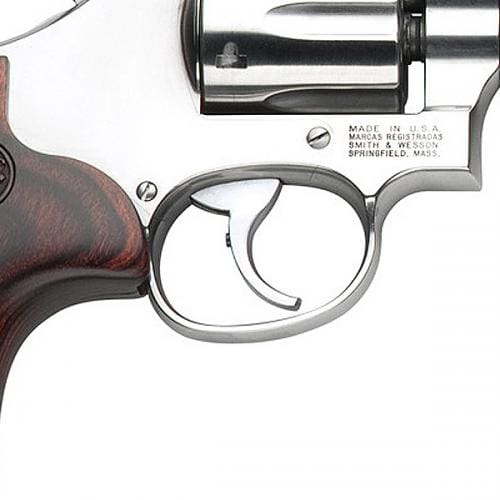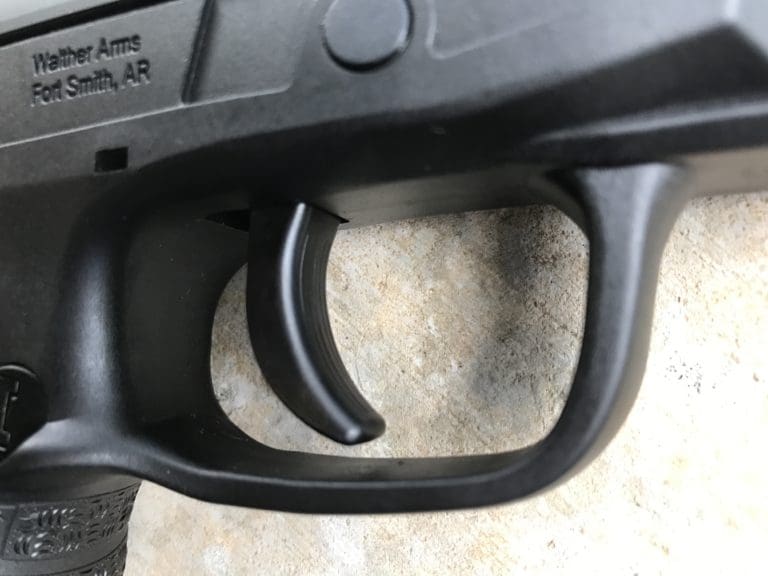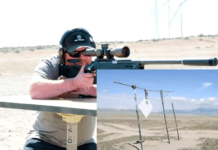A reader writes:
I read descriptions in reviews that say, “The trigger’s a bit gritty and prone to stacking.” I’ve never understood this. Educate me, please. What is stacking?
One of the major problems with talking about guns is that you’re often trying to convey a feeling with words. Having a common lexicon (standard set of words with known definitions) helps, but only if you’re “in the know.” We’ve gone over some of these terms in the distant past, but today we’ll try to be a little more comprehensive.
So here’s a listing of most of the terms you’ll hear when referring to triggers, whether that’s in a handgun, rifle or shotgun.
Blade
The “blade” of the trigger is the exposed portion to which the shooter applies pressure to fire the gun.
Break
A trigger’s “break” is the point at which the mechanism releases the hammer (or other mechanism that stores potential energy) to hit the firing pin and strike the primer. The trigger is depressed until it reaches the “wall.” Any further pressure “breaks” the trigger. It’s after this point that the firing of the round is out of the shooter’s control.
A trigger’s break can feel either crisp or soft depending on the shooter’s preference. Crisp triggers are typically preferred on rifles, where the trigger remains stationary until enough pressure has built up for it to release the firing pin.
Soft triggers (or “roll triggers”) are sometimes preferred by competition pistol shooters, which allows the trigger to continue to move backwards while the pressure builds before the break.
Double Action
This term is typically applied to pistols, but it can also be found in other weapons (like the M32 MGL). Unlike a single action trigger, which simply releases the gun’s hammer, a double action trigger will first move the hammer on the firearm backwards, imparting enough potential energy to strike the firing pin and ignite the round (cocking it). It will then release the hammer once enough energy is stored. This is accomplished in a long, heavy trigger pull to the rear.
Grit
In contrast to a “smooth” trigger pull, a “gritty” trigger feels as though the trigger is sliding over a rough surface as it’s depressed. The force required to pull the trigger may not increase consistently as it’s pulled, and will often result in a trigger having properties that are referred to as “stacking.”
Lock Time
After a trigger breaks, there’s a small amount of time between the break (the release of the sear) and when the firing pin actually strikes the round’s primer, igniting the powder. That time difference is called “lock time.” The shorter the better. A short lock time is particularly important for accuracy in long range precision shooting.
Over-Travel
Any additional rearwards movement of the trigger after the “break” is considered “over-travel.” The more the over-travel, the further the trigger finger must move forward in order to allow the trigger to “reset” before a follow-up shot. Excessive over-travel and reset distances can lead to decreased accuracy and may fatigue a trigger finger, especially in high round count situations (competition shooting, for example) and lowers the rate of fire for semi-automatic rifles.
Pre-Travel
This is sometimes confused with slack and take-up. Pre-travel is the total distance the trigger moves from rest until the trigger breaks.
Reach
The “reach” of a trigger is measured as the distance from the front of the trigger shoe (where your finger would apply pressure) to the front of the grip (behind the trigger). This is essentially a measure of how far forward the trigger is from the grip, which allows you to to determine if your finger is the proper size to manipulate it correctly.
If your figure doesn’t bend to about 90 degrees when the trigger has been fully depressed, or you have to adjust your grip to pull the trigger, your reach is probably too long.
Reset
After the “break,” and any “over-travel,” the goal is to make the trigger again ready for the next shot. The trigger must be “reset.” This is done by letting the trigger move forward again far enough to re-engage the trigger mechanism.
The trigger is usually returned automatically by an internal spring. All the operator needs to do is reduce pressure on the trigger and cycle the action (if not semi-automatic).
Some pistols have a short reset distance, allowing the shooter to take the next shot more rapidly. Some pistols require the trigger to travel all the way back to its resting position in order to fire the next shot. A trigger’s reset can usually be felt and sometimes even heard so you know when it’s ready to fire again.
Set
A trigger may sometimes be referred to as a “set” trigger. These triggers give the shooter the option to greatly decrease the force required to pull the trigger past the “break” without breaking out the screwdriver and tearing down the rifle. Sets are usually engaged via a mechanism that is easy to manipulate while the shooter has his sights on a target.
A single set trigger means the shooter applies force to the back of the trigger in order to engage the set. This (rather counter-intuitively) moves the trigger further forwards, in the opposite direction that one normally pulls a trigger.
A double set trigger requires the shooter to manipulate a lever or catch somewhere on the gun other than the trigger to engage the set.
Within set triggers, there are two types or “phases.” Single Phase set triggers require the set to be engaged before the trigger can be pulled. Double Phase triggers can be fired either with or without engaging the set. Phases are most common on Double Set triggers.
Shoe
A “trigger shoe” is like putting a veneer on your trigger. It’s the piece of material that is affixed to the blade of the trigger in order to make it wider or change some other characteristic of the trigger. Shoes are not typically permanent.
Single Action
A “single action” trigger is one where the only function of the trigger is to release the hammer (or other mechanism that stores potential energy) enabling it to strike the firing pin. That’s it. If the hammer (or mechanism) is already forward and has no potential energy (it isn’t cocked) then pulling the trigger will not do anything (unlike a “double action” trigger).
Good single action triggers have no “take-up” and are usually much lighter than double action triggers, and do not move backwards until after the “break.”
Single Stage
See the “single stage” section here for more detail, but essentially the trigger does not move until the pressure is sufficient for it to “break.”
Slack
The “slack” is the distance that the trigger moves backwards before any resistance is felt. On a two stage trigger it is this slack that comprises the first stage. Slack in a single stage trigger is usually considered a bad thing. See this post for more information.
Smooth
A “smooth” trigger is the opposite of a “gritty” trigger. When pulling a smooth trigger to the rear it will present a constantly increasing level of resistance (or simply constant resistance in a single stage trigger) and will feel like two smooth and oiled pieces of metal sliding across each other. Smooth triggers will not “stack.”
Stacking
Stacking is the increasing resistance the shooter feels as the trigger is pulled. A trigger that has “stacking” issues will require ever-increased pressure the closer you get to the trigger’s break. This can also be referred to as a “false break.”
In a trigger that has stacking issues the shooter needs to apply enough pressure to get past the “stack,” which is usually enough to move past the “break” as well once the “stack” has been passed. This means that it’s more difficult to control the firearm for precision shots.

Stop
The stop is a physical object (typically a piece of metal machined into the trigger or an adjustable screw) that limits the over-travel of the trigger. The stop will literally stop the trigger from moving any further backwards.
Take-Up
Also sometimes called “slack,” take-up is the first part of the trigger pull before you start to feel any resistance (when the trigger’s mainspring starts to engage).
Two Stage
A “two stage” trigger (sometimes called a double-stage trigger) , unlike a single stage trigger, has a bit of “slack” built into the trigger. The shooter takes up the slack in the trigger by applying a small amount of pressure to the trigger. Once the slack is taken up, the trigger reaches the “break” location and only needs a small further increase in pressure to break and fire the weapon.
Two stage triggers are useful especially in precision rifles because once the slack is taken up it only requires a very small amount of pressure to fire the gun, less than would be required (or safe) in a single stage trigger.





I can dig reasons for knowing trigger functionality, but if you’re a beginner, don’t sweat the trigger, your finger knows how to pull it. Just keep aiming through the trigger pull…not slow or fast, just pull it easy, and don’t take your mind off of aiming. Beyond the beginner stage, esp. target shooting? That’s another matter.
Then there’s an electric trigger/finger, cue Jerry Miculek.
You missed one: creep. Trigger creep is movement of the trigger rearward AFTER the take up, or slack. It does not need to be a two-stage trigger to have creep, the term only refers to the movement that should make the trigger “break”, but does not, because of excessive sear engagement. Instead, the sear only partly releases the hammer or striker, but a small part of the sear remains engaged.
I’ve fixed triggers with three stages of creep. All the slack is taken up, and then two more movements before the sear finally releases on the third try.
It’s not a DIY job to fix either. The fix is to hand stone and lap the sear/hammer engagement surfaces until they fit each other properly. Stone too much and the trigger will become unsafe(a “hair” trigger), and then it’s time for new parts and fit them all over again.
Some trigger designs have a set screw, and it can adjust the amount of sear engagement. If this screw is moved, it must be locktighted after the final adjustment is done. It will not stay perfectly in place otherwise, and a single thou is a big deal in this area. Even adjusting these type triggers should really be left to a competent gunsmith. And some triggers just have creep and there isn’t much to be done about it but learn to live with it.
So when a review describes a trigger break as “crisp” or breaks “like a plate of glass”, this is the opposite of a trigger with excessive creep?
Yes. Whatever the poundage of trigger pull, the best “feel” is if the sear breaks crisply and cleanly upon the first rearward movement of the trigger, and it breaks in the same way and with the same weight each time.
This is obviously much easier to achieve in a single-action trigger, which only releases a firing pin that is already cocked, and the double-action stroke, which must first cock itself and then release.
Sometimes when we’re getting ready to go somewhere we “reach” for a pair of pants during our “Pre-Travel” preparations. Occasionally we pick of pair of pants that look “smooth” but find that the pants are in fact too large for us because we usually carry IWB and this time we cannot. This “slack” in the waistband often results in “over-travel” in the leg area which causes “stacking” of the fabric around the ankle, above the “shoe”.
Rather than “reset” our clothing choices with a “single action” of changing which pair of pants we choose we instead “stop”, think, and choose to add a belt to our pants. This “double action” prevents a “two stage” process of having to take said pants to a tailor to have the tailor “take up” some of the fabric in the ankle area and instead allows us to wear chosen pants with a “single stage” of preparation.
Choosing an appropriate belt is key. You don’t want one that will “break” or which takes forever to put on because of a long “lock time” on the buckle. You also don’t want a poorly built belt with “grit” in the locking mechanism. For this reason, if you’re not trying to get dressed up but rather keep it kind of casual, “Blade”Tech makes a great belt that means you get be “set” and out the door quick as a flash.
Are you particularly bored this evening, Strych?
Spider venom does strange things.
Indeed. Sometimes it makes me think I have a tail.
Not really. Working out + insulin + a cup of coffee kinda winds me up like I’m a biker on crank but without all the strange side effects from abusing narcotics.
Then there are the different types of triggers, like set, hammer, striker, etc.
You forgot ‘dingus’.
ah yes, the dingus on the hoo- hah.
or the dringus at the keyboard. and pruppets.
Might also include technical descriptions of “booger hook”, and “bang switch”. 😉
When the perfect trigger pull / resistance is found be sure and let me know. I think there are way too many trigger snobs in this world.
Weird I was dreaming of triggers last night. Working on a 22, then the guy had an AD and sued me
This is a good piece. I wish I had come across something like this when I first got into firearms as a hobby instead of having to figure out these terms through context in reading countless gun reviews and articles. Good job.
Come back nick. Come back.
The last term in the list should be “Excuse: All above terms are used to describe why you missed/shot poorly”
Comments are closed.